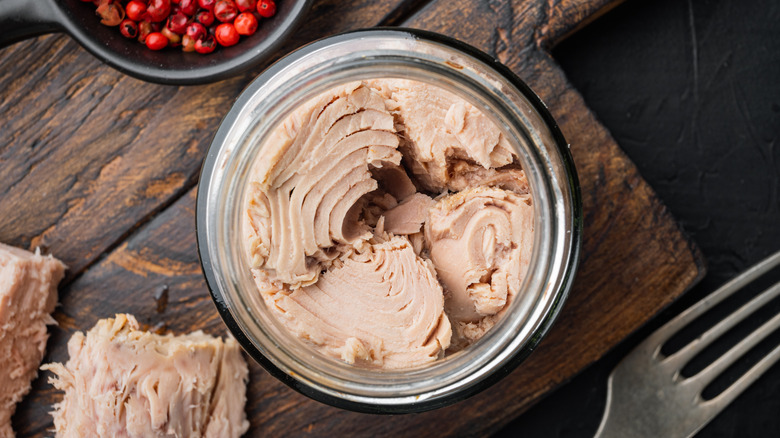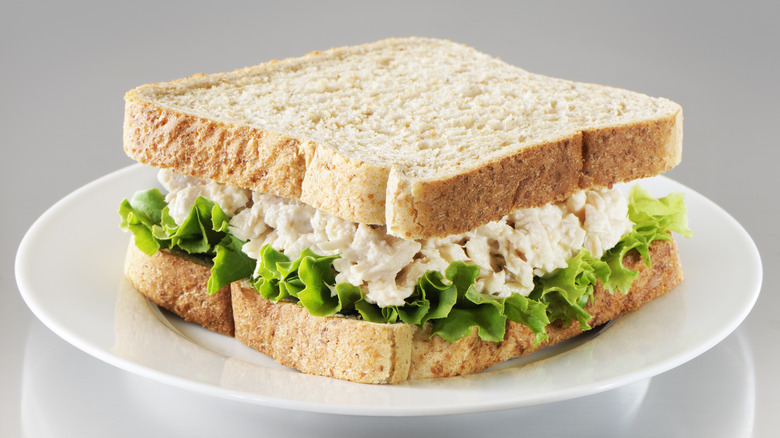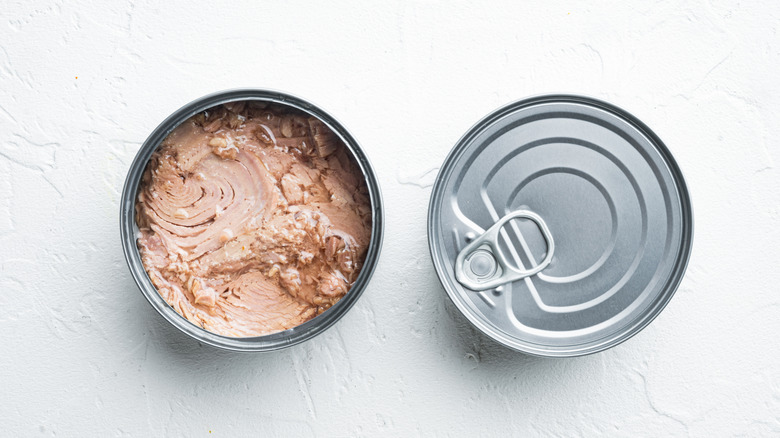What Are The Chances That You'd Get Mercury Poisoning From Canned Tuna?
Canned tuna is classically considered one of the healthier pantry staples. Although canned tuna is a processed food, it doesn't present the same health concerns as other processed meats, which contain nitrates, and it's generally a good source of protein and Omega-3 fatty acids. Sure, it can be bland at times, but there are plenty of ways to upgrade canned tuna with a little kitchen ingenuity, and it's one of the most affordable proteins available. There is, however, one controversy hanging over canned tuna — and canned fish in general — and that's mercury.
Mercury is a heavy metal that is toxic to humans, impairing vision, speech, hearing, and motor skills. It originates in the Earth's crust, and through a combination of geological activity and human pollution, some of it ends up in waterways where it gets absorbed by plankton. Fish eat the plankton and absorb mercury into their own bodies, then those fish are eaten by larger fish, which absorb the mercury into their bodies. This continues all the way up the food chain, and the concentration of mercury increases the higher up the chain you go. This is why tuna are of such concern when it comes to mercury poisoning — as large, predatory fish, they're high on the food chain and contain higher levels of mercury than most other commonly eaten fish, such as salmon or sardines. Consequently, canned tuna should be eaten in moderation, but it can still play a valuable role in your diet.
How much canned tuna is safe to eat?
Eating canned tuna a couple of times a week is perfectly fine, and for many, it's the most affordable way to get the nutritional benefits of seafood, like Omega-3 fatty acids. However, according to Medical News Today, canned tuna is also the leading contributor of mercury in many people's diets, and it's not suitable as an everyday meal.
The Dietary Guidelines for Americans recommends that adults eat at least two 4-ounce servings of fish each week, which is equal to two cans of tuna (tuna comes in short tins that are typically 5 ounces each, but about an ounce of that weight is water). This is also about the maximum amount of canned tuna you can safely eat, as the FDA recommends sticking to two to three servings per week.
Some kinds of canned tuna are safer than others. Light tuna, such as skipjack, is relatively low in mercury, and it's safe to eat up to three cans of it per week. Albacore tuna, which is a larger species, tends to have much higher levels of mercury, and the FDA recommends eating no more than one can of it per week. Some brands of canned albacore tuna have up to 10 times more mercury than light tuna varieties. Not only should you limit yourself to one serving of albacore a week, but if you eat this kind of tuna, you should not eat any other fish, period.
Pregnant people and children need to be more cautious about tuna
The risk of mercury poisoning is highest for pregnant people and children. Eating fish with high levels of mercury while pregnant can impair fetal development and cause a congenital condition known as Minamata disease. The effects of mercury poisoning on children can be severe, including seizures and reduced head size, but they can also be subtle and may go unnoticed until the child begins showing speech, memory, and coordination issues in school.
The FDA recommends that pregnant people continue eating fish for its nutritional benefits but that they choose low-mercury options such as canned light tuna. However, a food safety team at Consumer Reports tested the mercury levels in multiple varieties of canned tuna and found that, while most brands of light tuna were relatively low in mercury, some were significantly higher, closer to the levels seen in albacore. Due to this inconsistency, Consumer Reports recommends avoiding canned tuna altogether if you're pregnant.
Children can safely eat canned tuna, but they should be limited to lower quantities than adults. The FDA recommends that children 3 and under eat up to 2 ounces of fish a week, children ages 4 to 7 eat up to 4 ounces, and children 8 to 10 eat up to 6 ounces. Children 11 and up can eat an adult portion of canned tuna each week, but it's still wise to stick to light varieties.


